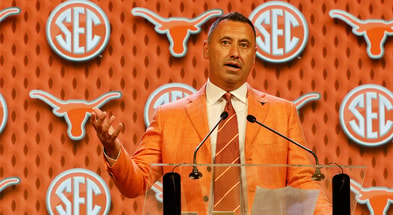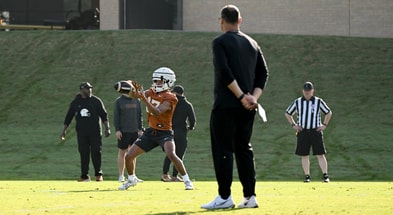Bad Take Tuesday: It's time to permanently honor the coaches of the 2000s. Yes, that includes Mack Brown

The 2000s were an unquestionable golden era for the men’s major sports in the Texas Longhorns athletic program. Baseball under Augie Garrido won two national championships and finished as runner-up for two others during the 10-year span. Men’s basketball under Rick Barnes made the NCAA tournament every season, reaching the 2003 Final Four along with two Elite Eights and two Sweet 16s. Most importantly, the Longhorn football team won 110 games in 10 seasons, three of four major bowl games it appeared in, and the 2005 national championship under Mack Brown.
[Join Inside Texas TODAY and get FOUR MONTHS for just ONE DOLLAR!]
That’s why for Bad Take Tuesday I say it’s time to put permanent honors of some form on the 40 Acres for those three coaches. Yes, that includes Brown.
Brown’s exit may have soured how some fans view his legacy. But it’s been over a decade, he’s out of the game of football, and, let’s not forget, he won the program’s first national championship in 35 years in the greatest game of all time. Aside from customary pictures on the wall in the facility and other trophies from that era, there’s nothing within the Longhorn athletics footprint that functions as a permanent honor to Brown.
Darrell Royal has the stadium named after him and a customary statue for his legendary achievements on the 40 Acres. Three national titles hardly begins to describe his accomplishments. But there’s a two-man club that consists of Royal and Brown of coaches that have won national championships in football at Texas, yet Brown doesn’t have some sort of permanent distinction?
This isn’t to say that Brown’s name should be added to the stadium. No.
Some people still bristle slightly at the fact that Royal’s name was attached to a building dedicated to our nation’s heroes. There’s not enough room for Brown’s name on “DKR” in more than one respect.
Texas also operates a certain way, or at least has for quite some time. The playing surface at Texas Memorial Stadium was named after longtime benefactor Joe Jamail until his sons requested that it be renamed in honor of Heisman winners Ricky Williams and Earl Campbell. The north end zone is named after Red McCombs. A portion of the east side of the stadium is named for Reese Rowling. The football facility is named after Tex Moncrief and Doc Neuhaus, two longtime benefactors.
That’s not to say Texas hasn’t honored the players associated with greatness. Williams and Campbell have statues. Vince Young and the other three national championship winning quarterbacks are honored on the southwest side of the stadium. Williams, Campbell, Young, Colt McCoy, Tommy Nobis, and Bobby Layne have their numbers retired.
But only one coach has been glorified for their national championship resume Texas. Fittingly so, to be sure.
It’s time for Brown to join Royal’s company.
So here’s an idea, along with a statue. Maybe something in Texas’ new Football Practice Facility can be named after Brown.
You could go all the way and name it the Brown Performance Center, or something along those lines. Without Brown, there is no Young sprinting for the pylon. There is no run for the record books from Williams in 1998. No McCoy, no Jordan Shipley, Brian Orakpo, Derrick Johnson, etc.
Putting Brown’s name on the facility, if not somewhere prominent in the facility to where an often-used part of it becomes synonymous with the building as a whole, is common in college sports.
Top 10
- 1Breaking
Jaydn Ott
Top transfer RB signs with OU
- 2Hot
Potential landing spots
For Nico Iamaleava
- 3Trending
Mel Kiper
3-Round Mock Draft
- 4
Marcus Freeman
Reacts to Nico Iamaleava
- 5
Brian Kelly reflects
On Kyren Lacy
Get the On3 Top 10 to your inbox every morning
By clicking "Subscribe to Newsletter", I agree to On3's Privacy Notice, Terms, and use of my personal information described therein.
Where does Ohio State call home when it’s not in Ohio Stadium? The Woody Hayes Athletic Center.
How about home base for Michigan? Bo Schembechler Hall.
And guess who Oklahoma’s operations home is named after? The Sooners call their shots from the Barry Switzer Center.
What’s stopping Texas from honoring Brown with something of a magnitude fitting of a national champion and the second-winningest head coach in program history? Brown’s time as a college head coach is over as his tenure is complete in North Carolina. He won multiple coach of the year awards at Texas. He’s already in the College Football Hall of Fame.
It’s time for something more permanent, and possibly something to long be associated with the athletic segment of Texas’ campus, to be associated with Brown.
There are other long overdue honors. Barnes is worthy of some distinction on the 40 Acres as the greatest men’s basketball coach in program history. The generous Moody family already put their names on the arena, but there’s yet to be a name placed on the court. Rick Barnes Court is something others in the Texas sphere have long advocated for and that makes total sense. Maybe Texas has to wait for Barnes’ time at Tennessee to conclude with a well-deserved retirement. The renaming of the court in Austin should be scheduled the next day.
You could likely say Garrido has received his permanent honors. No one in the Longhorn baseball program is ever going to wear No. 16 again, even if it hasn’t officially been retired. Garrido’s bust, along with likenesses of Billy Disch, Bibb Falk, and Cliff Gustafson, are outside of UFCU Disch-Falk Field in a section honoring the four national championship winning coaches from the Longhorn baseball program. Maybe there’s something to be named for him alongside Gustafson. There should be.
That trio deserves permanent honors. The circumstances of Brown’s exit from the 40 Acres are always going to be messy. But great figures in sports have their moments of weakness. Few have pristine careers without error.
Brown’s career will go down as one of the best in college football history. It’s undoubtedly the second best in Texas history, and features an elusive national championship that Texas struggled to so much as contend for until Steve Sarkisian got things going.
[Order THE LONGHORN ALPHABET today and teach your little ones the A to Z’s of Texas Football!]
Let bygones be bygones. Look fondly upon the past and celebrate it with something meaningful, momentous, and permanent for William Mack Brown.

























